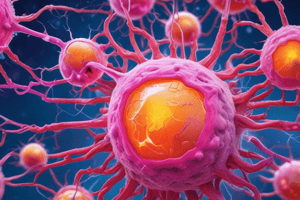Podcast
Questions and Answers
Which characteristic distinguishes carcinoma in situ from invasive carcinoma?
Which characteristic distinguishes carcinoma in situ from invasive carcinoma?
- Presence of metastasis
- Cellularity
- Involvement of the entire epithelium thickness
- Penetration of the basement membrane (correct)
What cellular mechanism is primarily responsible for the invasion of the basement membrane in invasive carcinoma?
What cellular mechanism is primarily responsible for the invasion of the basement membrane in invasive carcinoma?
- Release of collagenases and hydrolases (correct)
- Increased E-cadherin expression
- Enhanced cell-cell contacts via integrins
- Apoptosis of surrounding stromal cells
Which of the following best describes the role of the stroma in neoplastic growth?
Which of the following best describes the role of the stroma in neoplastic growth?
- Provides structural and nutritional support to neoplastic cells (correct)
- Directly participates in monoclonal proliferation
- Suppresses the growth of neoplastic cells
- Induces apoptosis in parenchymal cells
In the context of neoplastic progression, what process is typically associated with the loss of cell-cell contacts?
In the context of neoplastic progression, what process is typically associated with the loss of cell-cell contacts?
Which of the following features is characteristic of dysplasia but not necessarily of carcinoma in situ?
Which of the following features is characteristic of dysplasia but not necessarily of carcinoma in situ?
How does the growth pattern of a benign tumor typically differ from that of a malignant tumor?
How does the growth pattern of a benign tumor typically differ from that of a malignant tumor?
Which characteristic is most indicative of a malignant tumor's potential for aggressive behavior?
Which characteristic is most indicative of a malignant tumor's potential for aggressive behavior?
What distinguishes a hamartoma from a choristoma?
What distinguishes a hamartoma from a choristoma?
Which of the following factors has the greatest impact on the prognosis of a patient with cancer?
Which of the following factors has the greatest impact on the prognosis of a patient with cancer?
In the context of tumor grading, what does 'high-grade' typically indicate?
In the context of tumor grading, what does 'high-grade' typically indicate?
What is the primary mechanism by which carcinomas typically spread?
What is the primary mechanism by which carcinomas typically spread?
What is the correct order of cancer formation from normal cells?
What is the correct order of cancer formation from normal cells?
How do sarcomas primarily disseminate throughout the body?
How do sarcomas primarily disseminate throughout the body?
What cellular feature is most indicative of anaplasia?
What cellular feature is most indicative of anaplasia?
Which of the following best explains the term 'monoclonal proliferation' in the context of neoplasia?
Which of the following best explains the term 'monoclonal proliferation' in the context of neoplasia?
What is a key microscopic feature that differentiates dysplasia from normal tissue?
What is a key microscopic feature that differentiates dysplasia from normal tissue?
Which of the following statements best describes how the TNM staging system is applied in cancer diagnosis?
Which of the following statements best describes how the TNM staging system is applied in cancer diagnosis?
A pathologist examines a tissue sample and observes cells that have invaded the basement membrane, which is composed of collagen and other proteins. Which cellular process is most likely enabling this invasion?
A pathologist examines a tissue sample and observes cells that have invaded the basement membrane, which is composed of collagen and other proteins. Which cellular process is most likely enabling this invasion?
A researcher is studying a new drug that aims to prevent metastasis. Which of the following mechanisms of action would be most effective in achieving this goal?
A researcher is studying a new drug that aims to prevent metastasis. Which of the following mechanisms of action would be most effective in achieving this goal?
A pathologist is examining a biopsy from a suspicious skin lesion. The report indicates the presence of dysplasia but no invasion of the basement membrane. How should this condition be classified?
A pathologist is examining a biopsy from a suspicious skin lesion. The report indicates the presence of dysplasia but no invasion of the basement membrane. How should this condition be classified?
Which characteristic is most frequently observed in malignant neoplasms compared to benign tumors?
Which characteristic is most frequently observed in malignant neoplasms compared to benign tumors?
If immunohistochemistry of tumors identifies them as originating in the epithelium, how would these tumors be classified?
If immunohistochemistry of tumors identifies them as originating in the epithelium, how would these tumors be classified?
What distinguishes a leiomyosarcoma from a leiomyoma?
What distinguishes a leiomyosarcoma from a leiomyoma?
Which of the following types of tumors is most likely to spread via the bloodstream?
Which of the following types of tumors is most likely to spread via the bloodstream?
A new drug inhibits the action of metalloproteinases. What is the most likely intended effect of this drug?
A new drug inhibits the action of metalloproteinases. What is the most likely intended effect of this drug?
How does determining the "grade" of a tumor typically contribute to cancer management?
How does determining the "grade" of a tumor typically contribute to cancer management?
A patient has a tumor that is staged as T1N0M0. What does this staging generally indicate?
A patient has a tumor that is staged as T1N0M0. What does this staging generally indicate?
What is one key difference between a benign tumor and a malignant tumor regarding their interaction with surrounding tissues?
What is one key difference between a benign tumor and a malignant tumor regarding their interaction with surrounding tissues?
A pathologist reports that a sample shows 'loss of uniformity in cell size and shape' and 'increased nuclear:cytoplasmic ratio'. What condition do these findings suggest?
A pathologist reports that a sample shows 'loss of uniformity in cell size and shape' and 'increased nuclear:cytoplasmic ratio'. What condition do these findings suggest?
What role does fibronectin play in the metastatic process?
What role does fibronectin play in the metastatic process?
What is the significance of identifying atypical mitotic figures in a tumor sample?
What is the significance of identifying atypical mitotic figures in a tumor sample?
How does the presence of pleomorphism in tumor cells influence tumor grading?
How does the presence of pleomorphism in tumor cells influence tumor grading?
What is 'omentatal caking' and what does it signify?
What is 'omentatal caking' and what does it signify?
During a biopsy analysis, which finding would classify a tumor as anaplastic?
During a biopsy analysis, which finding would classify a tumor as anaplastic?
What is the term 'stroma' refer to in neoplastic context?
What is the term 'stroma' refer to in neoplastic context?
What is 'hematoma' when referring to patterns of cancerous spread?
What is 'hematoma' when referring to patterns of cancerous spread?
Flashcards
Neoplasia
Neoplasia
Uncontrolled, monoclonal cell proliferation that can be benign or malignant. It includes parenchyma and stroma.
Parenchyma (neoplasia)
Parenchyma (neoplasia)
The functional tissue of a tumor, consisting of neoplastic cells.
Stroma (neoplasia)
Stroma (neoplasia)
The supporting tissue of a tumor, including blood vessels and connective tissue.
Normal cells
Normal cells
Signup and view all the flashcards
Dysplasia
Dysplasia
Signup and view all the flashcards
Carcinoma in situ
Carcinoma in situ
Signup and view all the flashcards
Invasive carcinoma
Invasive carcinoma
Signup and view all the flashcards
Metastasis
Metastasis
Signup and view all the flashcards
Carcinoma
Carcinoma
Signup and view all the flashcards
Sarcoma
Sarcoma
Signup and view all the flashcards
Hamartoma
Hamartoma
Signup and view all the flashcards
Choristoma
Choristoma
Signup and view all the flashcards
Tumor Grade
Tumor Grade
Signup and view all the flashcards
Tumor Stage
Tumor Stage
Signup and view all the flashcards
Study Notes
- Neoplasia involves uncontrolled, monoclonal cell proliferation, and can be benign or malignant
- Neoplastic growth: parenchyma (neoplastic cells) & supporting stroma (non-neoplastic cells, vessels, connective tissue)
Neoplastic development stages
- Normal cells exhibit basal to apical polarity
- Dysplasia involves loss of uniformity in cell size/shape (pleomorphism), loss of tissue orientation & nuclear alterations, reversible
- Carcinoma in situ/preinvasive stage: severe dysplasia spans entire epithelium thickness, without penetrating basement membrane
- Invasive carcinoma: cells invade basement membrane using collagenases and hydrolases; cell-cell contacts lost via E-cadherin inactivation; cells attach to fibronectin to spread
- Metastasis: cancer spreads to distant organs via lymphatic system or blood
Tumor Nomenclature
- Carcinoma: epithelial origin, spread via lymph nodes
- Sarcoma: mesenchymal origin, spread via blood
- Benign tumors: well-differentiated, well-demarcated, low mitotic activity, no metastases or necrosis
- Malignant tumors (cancers): poor differentiation, erratic growth, local invasion, metastasis, decreased apoptosis, pleomorphic, hyperchromatic nuclei sizes and shapes vary
Malformation terms
- Hamartoma: disorganized overgrowth of tissues in native location
- Choristoma: normal tissue in a foreign location
Benign vs Malignant Tumors
- Adenoma/papilloma: benign epithelial tumor
- Adenocarcinoma/papillary carcinoma: malignant epithelial tumor
- Hemangioma: benign blood vessel tumor
- Angiosarcoma: malignant blood vessel tumor
- Leiomyoma: benign smooth muscle tumor
- Leiomyosarcoma: malignant smooth muscle tumor
- Rhabdomyoma: benign striated muscle tumor
- Rhabdomyosarcoma: malignant striated muscle tumor
- Fibroma: benign connective tissue tumor
- Fibrosarcoma: malignant connective tissue tumor
- Osteoma: benign bone tumor
- Osteosarcoma: malignant bone tumor
- Lipoma: benign fat tumor
- Liposarcoma: malignant fat tumor
- Nevus/mole: benign melanocyte tumor
- Melanoma: malignant melanocyte tumor
Tumor Grade vs Stage
- Grade: degree of cell differentiation and mitotic activity, low-grade to high-grade; requires biopsy
- Stage: degree of invasion and spread, based on clinical or pathological findings; uses TNM staging system
- T: Primary tumor size/invasion.
- N: Regional lymph node metastasis.
- M: Distant metastasis.
- Stage is more prognostic than grade because spread determines survival
Studying That Suits You
Use AI to generate personalized quizzes and flashcards to suit your learning preferences.





